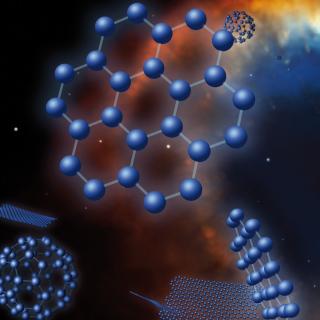Marini, E.; Dell'Agli, F.; Groenewegen, M. A. T.; García-Hernández, D. A.; Mattsson, L.; Kamath, D.; Ventura, P.; D'Antona, F.; Tailo, M.
Bibliographical reference
Astronomy and Astrophysics
Advertised on:
3
2021
Journal
Citations
16
Refereed citations
15
Description
Context. Carbon stars have been, and still are, extensively studied. Given their complex internal structure and their peculiar chemical composition, they are living laboratories in which we can test stellar structure and evolution theories of evolved stars. Furthermore, they are the most relevant dust manufacturers, thus playing a crucial role in the evolution of galaxies.
Aims: We aim to study the dust mineralogy of the circumstellar envelope of carbon stars in the Large Magellanic Cloud (LMC) to achieve a better understanding of the dust formation process in the outflow of these objects. We intend to investigate the expected distribution of carbon stars in the observational planes built with the filters of the Mid-Infrared Instrument (MIRI) mounted onboard the James Webb Space Telescope (JWST) to select the best planes allowing an exhaustive characterisation of the stars.
Methods: We compared the synthetic spectral energy distributions, obtained by modelling asymptotic giant branch stars and the dust formation process in the wind, with the spectra of carbon stars in the LMC, taken with the Infrared Spectrograph onboard the Spitzer Space Telescope. From the detailed comparison between synthetic modelling and observation we characterise the individual sources and derive the detailed mineralogy of the dust in the circumstellar envelope.
Results: The sample of stars considered here is composed of stars of diverse mass, formation epoch, degree of obscuration, and metallicity. We find that precipitation of MgS on SiC seeds is common to all non-metal-poor carbon stars. Solid carbon is the dominant dust component, with percentages above 80% in all cases; a percentage between 10% and 20% of carbon dust is under the form of graphite, the remaining being amorphous carbon. Regarding the observational planes based on the MIRI filters, the colour-magnitude ([F770W]-[F1800W], [F1800W]) plane allows the best understanding of the degree of obscuration of the stars, while the ([F1800W]-[F2550W], [F1800W]) diagram allows better discrimination among stars of different metallicities.
Aims: We aim to study the dust mineralogy of the circumstellar envelope of carbon stars in the Large Magellanic Cloud (LMC) to achieve a better understanding of the dust formation process in the outflow of these objects. We intend to investigate the expected distribution of carbon stars in the observational planes built with the filters of the Mid-Infrared Instrument (MIRI) mounted onboard the James Webb Space Telescope (JWST) to select the best planes allowing an exhaustive characterisation of the stars.
Methods: We compared the synthetic spectral energy distributions, obtained by modelling asymptotic giant branch stars and the dust formation process in the wind, with the spectra of carbon stars in the LMC, taken with the Infrared Spectrograph onboard the Spitzer Space Telescope. From the detailed comparison between synthetic modelling and observation we characterise the individual sources and derive the detailed mineralogy of the dust in the circumstellar envelope.
Results: The sample of stars considered here is composed of stars of diverse mass, formation epoch, degree of obscuration, and metallicity. We find that precipitation of MgS on SiC seeds is common to all non-metal-poor carbon stars. Solid carbon is the dominant dust component, with percentages above 80% in all cases; a percentage between 10% and 20% of carbon dust is under the form of graphite, the remaining being amorphous carbon. Regarding the observational planes based on the MIRI filters, the colour-magnitude ([F770W]-[F1800W], [F1800W]) plane allows the best understanding of the degree of obscuration of the stars, while the ([F1800W]-[F2550W], [F1800W]) diagram allows better discrimination among stars of different metallicities.
Related projects

Nucleosynthesis and molecular processes in the late stages of Stellar Evolution
Low- to intermediate-mass (M < 8 solar masses, Ms) stars represent the majority of stars in the Cosmos. They finish their lives on the Asymptotic Giant Branch (AGB) - just before they form planetary nebulae (PNe) - where they experience complex nucleosynthetic and molecular processes. AGB stars are important contributors to the enrichment of the
Domingo Aníbal
García Hernández